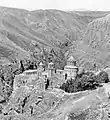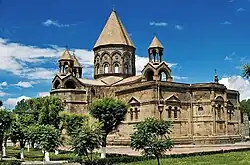| Khtzkonk monastery | |
|---|---|
 Khtzkonk in the early 20th century | |
| Religion | |
| Affiliation | Armenian Apostolic Church |
| Ecclesiastical or organizational status | Monastery |
| Status | Abandoned after 1920, partially destroyed by Turkish Army in the 1950s |
| Location | |
| Location | Digor District |
 Shown within Turkey | |
| Geographic coordinates | 40°22′50″N 43°22′35″E / 40.380556°N 43.376389°E |
| Architecture | |
| Style | Armenian |
| Groundbreaking | Seventh century |
| Completed | Thirteenth century |
Khtzkonk Monastery (Armenian: Խծկոնք, also transcribed as Khtskonk and Xc'konk'; Turkish: Beşkilise) was a monastic ensemble of five Armenian churches built between the seventh and thirteenth centuries in what was then the Armenian Bagratid kingdom.[1] The site is located near the town of Digor, the administrative capital of the Digor District of the Kars Province in Turkey, about 19 kilometres west of the border with Armenia, in a gorge formed by the Digor River.
Present condition
The monastery with its five churches was intact when photographed by the Armenian archaeologist Ashkharbek Kalantar in August 1920, just before Turkey captured the region from Armenia.[2] In 1959 the French art historian Jean-Michel Thierry visited the site and found that four of the five churches had been destroyed, with only the Church of Saint Sargis surviving.[3] While historian Thomas Sinclair in 1987 ventured an explanation that the buildings were destroyed by "rolling rocks,"[4] others, including locals themselves, have attested that the churches were blown up by the Turkish army using high explosive rounds, which was reaffirmed by the residents of Digor in 2002.[5] Their information is corroborated by the physical evidence on the site which "seems to confirm that these buildings were intentionally destroyed with modern, probably military means" as part of "a phenomenon that could be defined as cultural genocide."[6] The dome of the surviving church is intact but the side walls have been blown outwards; the destroyed churches have been entirely leveled with their masonry blasted into the gorge below. This is damage that cannot have occurred as a result of an earthquake, William Dalrymple wrote similarly in 1989.[7]
Gallery
 Khtzkonk, as seen in 1920.
Khtzkonk, as seen in 1920. Khtzkonk, as seen in the early 20th century.
Khtzkonk, as seen in the early 20th century.
 Khtzkonk today.
Khtzkonk today.




 Walls of the church of Saint Sargis
Walls of the church of Saint Sargis Inscription
Inscription Interior walls
Interior walls The dome
The dome Desecrated graveyard above monastery
Desecrated graveyard above monastery Gravestone
Gravestone Remains of church of Saint Gregory
Remains of church of Saint Gregory


Notes
- ↑ Sinclair, Thomas A. (1987), Eastern Turkey: An Architectural and Archaeological Survey, vol. 1. London: Pindar Press, p. 421.
- ↑ Kalantar, Ashkharbek (1994), Armenia From the Stone Age to the Middle Ages, Selected Papers, Neuchâtel: Recherches et Publications, pp. 84-89.
- ↑ (in French) Thierry, Jean-Michel, "Notes Sur des Monuments Armeniens en Turquie (1964)," Revue des Études Arméniennes 2 (1965), pp. 165-84.
- ↑ Sinclair. Eastern Turkey, p. 421.
- ↑ Hofmann, Tessa (2003). Armenians in Turkey Today: A Critical Assessment of the Situation of the Armenian Minority in the Turkish Republic. Brussels: Forum of Armenian Associations of Europe, p. 40.
- ↑ Ivan Foletti and Stefano Riccioni, "Inventing, Transforming and Discovering Southern Caucasus," Venezia Arti27 (December 2018), p. 8.
- ↑ Dalrymple, William , "Armenia's Other Tragedy," The Independent Magazine, 18 March 1989.
External links
- The Monastery օf Khtzkonk on VirtualAni.org
- Gagik Arzumanyan's photo gallery
- Image gallery of Khtzkonk at Research on Armenian Architecture's website
- Images from 1968 at the Gateway to Armenian Cultural Heritage website



